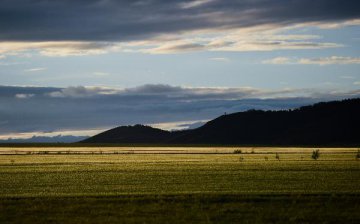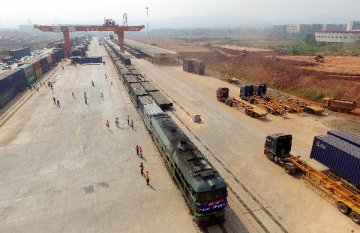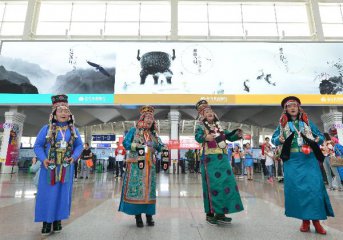
As Mellat Dilnar, a student from Kazakhstan who has been pursuing her studies in Beijing for three years, lets breeze gently move her hair in front of the ancient ruins of Ulanqab, she feels like she is back in the boundless steppe of her home country.
"The idea of the Silk Road has been with me since I was a child," said Dilnar, who is starting her thesis on the Silk Road for her doctorate study. "Caravans used to travel from here to my hometown of Almaty and beyond."
Literally meaning "red mountain ridges" in Mongolian, the city of Ulanqab in north China's Inner Mongolia Autonomous Region lies at the pass of Mount Yinshan.
It remained a key station of the Silk Road on the grasslands, a divergent branch to China's traditional land route to the West, until the city was destroyed amid rebellions in the mid-14th century.
"We always say that China is the ocean and port of Kazakhstan," said Dilnar. "The old route now has a new orientation."
The ancient trade depot sees an opportunity to relive the past grandeur since the Belt and Road Initiative -- the proposal for building of the Silk Road Economic Belt and the 21st Century Maritime Silk Road -- was put forward by China five years ago.
OLD ROUTE, NEW STYLE
"Among China Railway Express's 17 hubs on the way to Europe, Ulanqab is the only non-provincial capital," said Wang Xinyu, vice mayor of Ulanqab.
Since the first China-Europe freight train from Chongqing to Duisburg of Germany was launched in 2011, there have been more than 10,000 trips and the trains continue to serve as a crucial network of the Silk Road Economic Belt.
Last year alone, there were 111 China-Europe freight trains sent from Ulanqab, accounting for 80 percent of the region's total.
"Opening-up and boosting trade are our top priorities," said Vice Mayor Wang. "The China-Mongolia-Russia Economic Corridor is an opportunity for us."
The upgraded transport link with China's northern neighbors has opened international markets for Ulanqab's traditional businesses such as its leather industry. Leather making companies from Beijing and Shanghai have moved here to better serve Russian and European customers.
"Not only does local cargo converge in Ulanqab, but cargo from north China or even across the country also comes here for redistribution," Wang said.
The old trade center now has a new ambition. A logistical channel that connects Ulanqab with Mongolia's Ulan Bator and Russia's Ulan Ude is being planned. It will be 1,160 km shorter than the current China-Russia trade route.
INNER MONGOLIA AND ITS WORLD VISION
Inner Mongolia Autonomous Region is now more than ever involved in global connectivity.
The region's Erenhot and Manzhouli to the north of Ulanqab are the mainstays of border connections with Mongolia and Russia. Last year, 569 China-Europe freight trains passed through Erenhot, and more than 1,300 through Manzhouli.
In the first seven months of 2018, the trade volume between Inner Mongolia and countries participating in the Belt and Roald Initiative reached 5.73 billion U.S. dollars, up 6.4 percent year on year, or accounting for 67.8 percent of the Inner Mongolia autonomous region's foreign trade volume.
"Inner Mongolia has become a logistics hub for sending Chinese goods to Europe," said Xu Jun, senior vice president of Prologis, a logistics real estate company. "We expect to fit our role in the region's development with the company's business in Europe."
The complementarity between China and the rest of the world in the past centuries is taking a new form in the trade through Inner Mongolia.
Agricultural and mechanical commodities, steel, automobiles and hi-tech products are among the exports. Products such as coal, wood and copper, iron and lead ores are among the major imports.
In August 2018, China and Mongolia agreed that the bilateral trade should reach 10 billion U.S. dollars by 2020. Inner Mongolia's role as a passageway will be further underlined.
"We will be back in Inner Mongolia for further research later this year to seek opportunities to provide high-quality logistics infrastructure for the region," Xu said.



















Latest comments